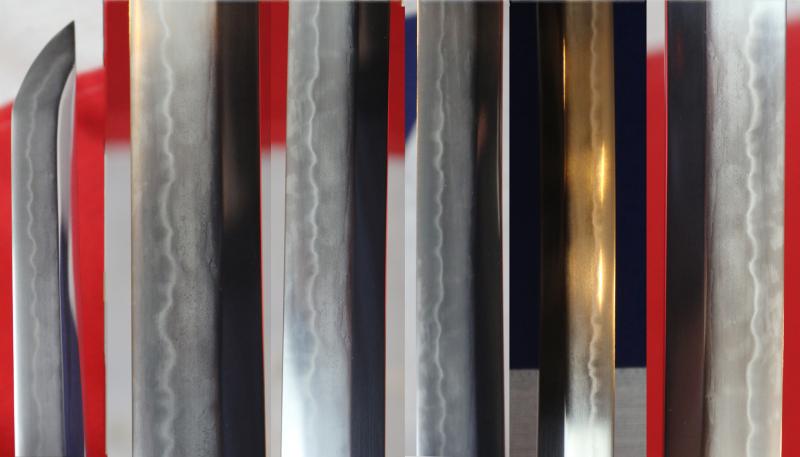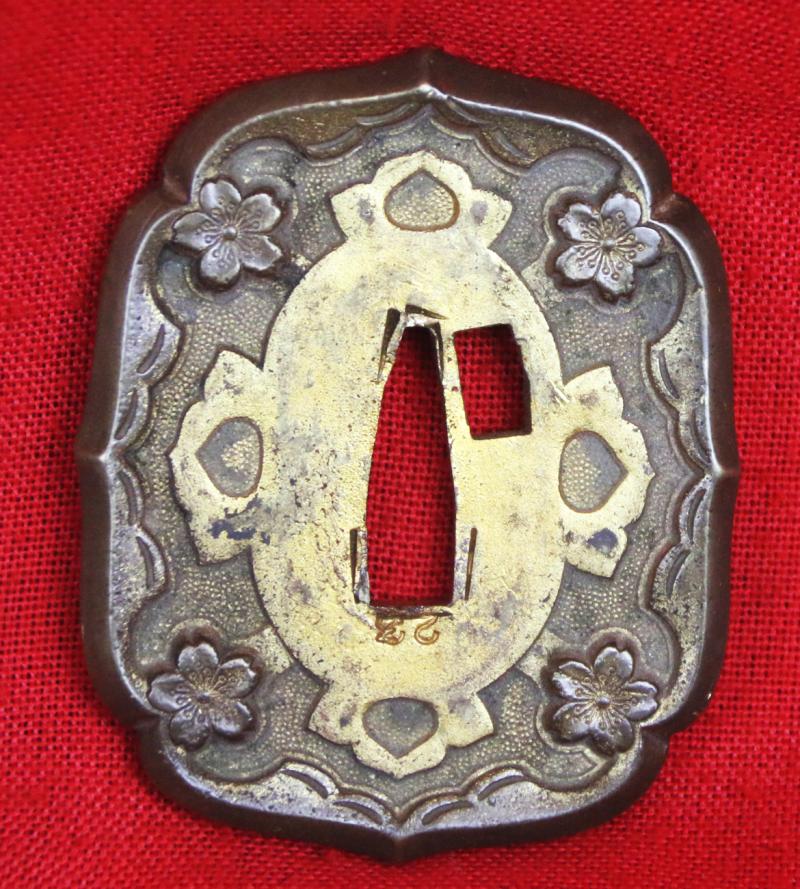A Superb Superior Gendaito Signed By Master Smith Ishido Teruhide. A Finest Grade Japanese Officer’s Katana, in Regulation Type 98 Koshirae.
This is 5 star grade sword by one of the highest regarded traditional sword smiths of WW2, In exceptional condition, with a beautiful, traditionally made gendai blade showing a remarkable hamon. Regulation 98 shingunto sword koshirae, in very good condition, The saya is traditional green lacquer painted with good brass type 98 fittings, single belt suspension ring and semegane; It has a tsuka of traditional wood, wrapped in brown silk Ito over white samegawa (ray skin), standard 38 pattern brass military mounts including, menuki, fuchi, tsuba with, kabutogane with sarute in brass with sakura, and menuki decorated with sakura and chrysanthemums.
The fuchi has a circular press-button aperture for an optional military button catch, as a way to lock the blade into the saya. The regulation saya retaining press button in the fuchi was often removed by the Japanese officer, and in fact was very often the case. On this sword the button was removed. The button clip was designed to hold the blade within its saya {scabbard} while ‘on the run” so to speak. This was a technical safety advantage, however, officers trained in iaido {the traditional martial art of the drawing of the sword from its saya} had no such fitting on regular katana, and if it was the button could cause a millisecond or even more of delay in combat, which by traditional swordplay standards is not only unacceptable it was also, potentially, a fatal drawback and disadvantage to the swordsman. Thus, they often removed and discarded this feature from the sword entirely.
The Ishido School has roots back to Osaka in the early Shinto Period. They made excellent swords in the Bizen Tradition. Tatara Nagayuki, the Ishido School’s most well regarded swordsmith, made swords that emulated, and sometimes rivaled those of the famous Ichimonji School of the Koto Period.
“Ishido Teruhide (b 1900; d 1982) was the 10th and last generation of the Ishido Korekazu line of swordsmiths in Tokyo (Toto). He was a descendant of very famous Musashi Daijo Fujiwara Korekazu.
During WW II, he made many swords for high ranking military officers, colonels and generals, and also made blades for civilians.
Ishido Teruhide was ranked betseki in the 1943 swordsmith rankings by the Nihon Token Tanrenjo and the Nihon Token Shinbunshi. “Ishido Teruhide (b 1900; d 1982) was the 10th and last generation of the Ishido Korekazu line of swordsmiths in Tokyo (Toto). He was a descendant of very famous Musashi Daijo Fujiwara Korekazu. During WW II, he made many swords for high ranking military officers and also made blades for civilians. Ishido Teruhide was ranked betseki in the 1943 swordsmith rankings by the Nihon Token Tanrenjo and the Nihon Token Shinbunshi.
Ishido Teruhide signed with both a long mei and a two character mei. Teruhide also signed simply Ishido saku kao. On some of his swords, Teruhide used a kao (carved personal seal) in addition to his signature (mei). Ishido Teruhide also signed as Ishido Mitsunobu also using the same kao as with his Teruhide mei. It is possible that the Mitsunobu signature is a dai mei signature (a signature where one smith signs for another). It could also be the case that both swordsmiths employed the same professional mei carver and that these signatures are examples of nakirishi mei. While these are possibilities, It is unlikely and that Teruhide and Mitsunobu are most probably the same smith. It is doubtful that a swordsmith would carve his personal seal (kao) if signing for another smith.
It has been suggested that he signed Teruhide when making blades by the traditional method but signed Mitsunobu on non-traditionally made (sunobe) blades. His signature (mei) is sometimes translated as Sekido Teruhide and Sekido Mitsunobu, although Ishido is the preferred reading.
An Ishido Teruhide blade was awarded HOZON origami in 1997 by the NBTHK and are judged as true gendaito (kindaito). His blades are found in standard shin-gunto mounts, Showa Era civilian buke’ zukuri style mounts, kai-gunto mounts and shirasaya. After the war Teruhide made wood cutting planes rather than swords in order to earn a living. The planes he produced cut well and sold for about 2,000,000 Japanese Yen.
The IJN launched a surprise attack on Pearl Harbor, killing 2,403 Americans and crippling the US Pacific Fleet. During the first six months of the Pacific War, the IJN enjoyed spectacular success inflicting heavy defeats on Allied forces. Allied navies were devastated during the Japanese conquest of Southeast Asia. Japanese naval aircraft were also responsible for the sinkings of HMS Prince of Wales and HMS Repulse which was the first time that capital ships were sunk by aerial attack while underway. In April 1942, the Indian Ocean raid drove the Royal Navy from South East Asia.
In 1943, the Japanese also turned their attention to the defensive perimeters of their previous conquests. Forces on Japanese held islands in Micronesia were to absorb and wear down an expected American counteroffensive. However, American industrial power become apparent and the military forces that faced the Japanese in 1943 were overwhelming in firepower and equipment. From the end of 1943 to 1944 Japan's defensive perimeter failed to hold.
The defeat at the Philippine Sea was a disaster for Japanese naval air power with American pilots terming the slanted air/sea battle the Great Marianas Turkey Shoot, mostly going in the favour of the US,126 while the battle of Leyte Gulf led to the destruction of a large part of the surface fleet. During the last phase of the war, the Imperial Japanese Navy resorted to a series of desperate measures, including a variety of Special Attack Units which were popularly called kamikaze. By May 1945, most of the Imperial Japanese Navy had been sunk and the remnants had taken refuge in Japan's harbours. By July 1945, Nagato was the only remaining ship of the Imperial Japanese Navy's capital ships that had not been sunk in raids by the United States Navy
Every single item from The Lanes Armoury is accompanied by our unique Certificate of Authenticity. Part of our continued dedication to maintain the standards forged by us over the past 100 years of our family’s trading, as Britain’s oldest established, and favourite, armoury and gallery
26.75 inch blade tsuba to tip, overall 39.5 inches long in saya
Code: 25415










